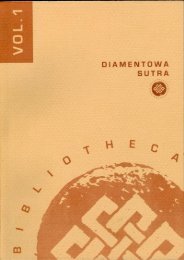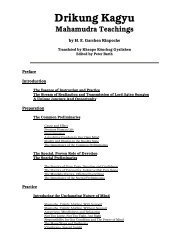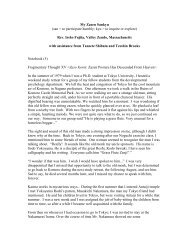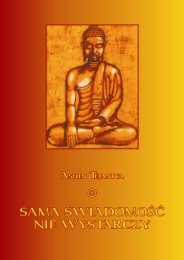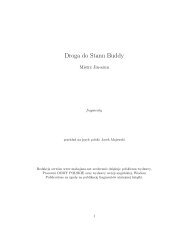3 - Computing in the Humanities and Social Sciences
3 - Computing in the Humanities and Social Sciences
3 - Computing in the Humanities and Social Sciences
You also want an ePaper? Increase the reach of your titles
YUMPU automatically turns print PDFs into web optimized ePapers that Google loves.
of mantras. 17 K¥kai also authored an important <strong>the</strong>oretical text on shittan, entitled Bonji<br />
shittan jimo narab<strong>in</strong>i shakugi, <strong>and</strong> of manuals on <strong>the</strong> writ<strong>in</strong>g <strong>and</strong> pronunciation of <strong>the</strong><br />
Indian characters.<br />
After K¥kai, all <strong>the</strong> most important Japanese monks who went to Ch<strong>in</strong>a to study<br />
went back to <strong>the</strong>ir country with several texts written <strong>in</strong> shittan characters. All <strong>the</strong><br />
material concern<strong>in</strong>g shittan exist<strong>in</strong>g <strong>in</strong> Japan at <strong>the</strong> end of <strong>the</strong> n<strong>in</strong>th century was<br />
collected <strong>and</strong> systematized <strong>in</strong> 884 by <strong>the</strong> Tendai monk Annen (ca. 841-915) <strong>in</strong> <strong>the</strong><br />
shittangaku encyclopedia entitled Shittanzø (T. 84). Subsequently, <strong>the</strong> <strong>in</strong>creas<strong>in</strong>g<br />
importance of esoteric Buddhism determ<strong>in</strong>ed <strong>the</strong> rapid diffusion of shittan, as an<br />
<strong>in</strong>dispensable component of Tendai <strong>and</strong> Sh<strong>in</strong>gon teach<strong>in</strong>gs <strong>and</strong> practices. (See van<br />
Gulik 1980 <strong>and</strong> Iyanaga 1983). The diffusion of <strong>the</strong>se characters is also testified by <strong>the</strong>ir<br />
<strong>in</strong>creas<strong>in</strong>g presence <strong>in</strong> texts. Even K¥kai wrote only a few shittan characters <strong>in</strong> his<br />
works; but s<strong>in</strong>ce <strong>the</strong> end of <strong>the</strong> Heian period <strong>the</strong>re was <strong>the</strong> tendency to write most (if<br />
not all) mantras <strong>and</strong> dhåra√∆ <strong>in</strong> shittan script, often without transcription. Shittan were<br />
commonly used <strong>in</strong> esoteric Buddhist texts <strong>and</strong> ritual manuals until <strong>the</strong> end of <strong>the</strong> Edo<br />
period (mid-n<strong>in</strong>eteenth century). In fact, it is at that time that <strong>the</strong> most complete<br />
collection ever of shittan-related documents was compiled: <strong>the</strong> monumental Bongaku<br />
shiryø (“Documents on Sanskrit Learn<strong>in</strong>g”) <strong>in</strong> one thous<strong>and</strong> scrolls compiled by <strong>the</strong><br />
Sh<strong>in</strong>gon monk Onkø Jiun (1718-1804) at <strong>the</strong> end of <strong>the</strong> eighteenth century. (On Jiun see<br />
Watt 1984).<br />
Knowledge <strong>and</strong> practices concern<strong>in</strong>g <strong>the</strong> shittan spread also outside <strong>the</strong> religious<br />
milieu <strong>and</strong> <strong>in</strong>fluenced <strong>the</strong> philosophical <strong>and</strong> cultural world of premodern Japan. Even<br />
though a cultural history of Shittan studies <strong>in</strong> Japan is still to be written, <strong>the</strong> phonetic<br />
structure of Sanskrit (var√apå†ha) <strong>in</strong>fluenced <strong>the</strong> development of Japanese kana phonetic<br />
scripts. Shittan studies were also directly connected with <strong>the</strong> philological <strong>and</strong><br />
philosophical discussions of <strong>the</strong> Edo period <strong>and</strong> <strong>the</strong> birth of <strong>the</strong> Nativist movement<br />
with Keich¥ (1640-1701). A general cultural trend considered shittan characters as<br />
microcosms, condensations of <strong>the</strong> esoteric universe. A good example of this <strong>in</strong>tellectual<br />
attitude is <strong>the</strong> Kamakura texts entitled Shittanr<strong>in</strong> ryakuzu shø by Ryøson (T 84).<br />
Fur<strong>the</strong>rmore, s<strong>in</strong>ce <strong>the</strong> Heian period shittan characters began to be written on funerary<br />
monuments, pagodas, <strong>and</strong> amulets; <strong>in</strong> this way, <strong>the</strong>y also spread outside of monastic<br />
<strong>and</strong> <strong>in</strong>tellectual circles <strong>in</strong>to <strong>the</strong> general populace. Even today, funerary tablets (ihai) <strong>and</strong><br />
17 K¥kai, Shørai mokuroku, <strong>in</strong> DNBZ 2: 16-28. A portion of <strong>the</strong> text is translated <strong>in</strong> Yoshito S. Hakeda,<br />
K¥kai: Major Works. New York: Columbia University Press, 1972, pp. 144.<br />
26



![Shushogi, Dogen Zenji [PDF] - Mahajana.net](https://img.yumpu.com/50921105/1/190x219/shushogi-dogen-zenji-pdf-mahajananet.jpg?quality=85)


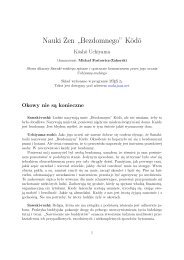

![wywiadu z Murakami Kosho Roshim [PDF] - Buddyzm w Polsce i na ...](https://img.yumpu.com/45809746/1/184x260/wywiadu-z-murakami-kosho-roshim-pdf-buddyzm-w-polsce-i-na-.jpg?quality=85)
